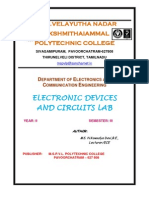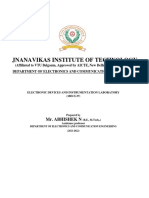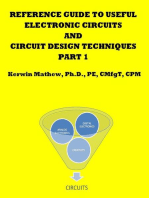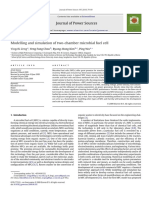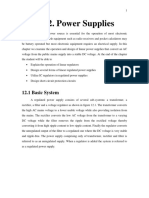Lab Manual 5-9
Lab Manual 5-9
Uploaded by
muhammadCopyright:
Available Formats
Lab Manual 5-9
Lab Manual 5-9
Uploaded by
muhammadOriginal Description:
Original Title
Copyright
Available Formats
Share this document
Did you find this document useful?
Is this content inappropriate?
Copyright:
Available Formats
Lab Manual 5-9
Lab Manual 5-9
Uploaded by
muhammadCopyright:
Available Formats
Student Lab Manual Group 5
National University of Sciences & Technology
FULL – WAVE RECTIFIER
Lab 05
EE 212-Basic Electronics
Instructor: Mr Afzal
DEPARTMENT OF ELECTRONICS & POWER ENGINEERING
EE 212 Basic Electronics 17 PN Engineering College
Student Lab Manual Group 5
Experiment 05
FULL – WAVE RECTIFIER
Objective: -
To find the Ripple factor and regulation of a Full-wave Rectifier with and without filter.
APPARATUS: -
Experimental Board
Transformer (12-0-12v).
P-n Diodes, (lN4007) ---2Nos
Multimeters –2Nos
Filter Capacitor (100μF/25v) -
Connecting Wires
Load resistor, 1KΩ
THEORY: -
The circuit of a center-tapped full wave rectifier uses two diodes D1&D2. During positive
half cycle of secondary voltage (input voltage), the diode D1 is forward biased and D2is reverse
biased.
The diode D1 conducts and current flows through load resistor RL. During negative half cycle,
diode D2 becomes forward biased and D1 reverse biased. Now, D2 conducts and current flows
through the load resistor RL in the same direction. There is a continuous current flow through the
load resistor RL, during both the half cycles and will get unidirectional current as show in the
model graph. The difference between full wave and half wave rectification is that a full wave
rectifier allows unidirectional (one way) current to the load during the entire 360 degrees of the
input signal and half-wave rectifier allows this only during one half cycle (180 degree).
CIRCUIT DIAGRAM: -
Without Filter:
EE 212 Basic Electronics 18 PN Engineering College
Student Lab Manual Group 5
With Filter :
PROCEDURE:
1. Connections are made as per the circuit diagram.
2. Connect the ac mains to the primary side of the transformer and the secondary side to the rectifier.
3. Measure the ac voltage at the input side of the rectifier.
4. Measure both ac and dc voltages at the output side the rectifier.
5. Find the theoretical value of the dc voltage by using the formula Vdc=2Vm/П
6. Connect the filter capacitor across the load resistor and measure the values of Vac and Vdc at the
output.
7. The theoretical values of Ripple factors with and without capacitor are calculated.
8. From the values of Vac and Vdc practical values of Ripple factors are calculated. The practical
values are compared with theoretical values.
THEORITICAL CALCULATIONS: -
Vrms = Vm/ √2
Vm=Vrms√2
Vdc=2Vm/П
(i)Without filter:
Ripple factor, r = √ ( Vrms/ Vdc )2 -1 = 0.482
(ii)With filter:
Ripple factor, r = 1/ (4√3 f C RL) where f =50Hz
C =100µF
RL=1KΩ
PRACTICAL CALCULATIONS:
Without filter:-
Vac=
Vdc=
Ripple factor, r=Vac/Vdc
EE 212 Basic Electronics 19 PN Engineering College
Student Lab Manual Group 5
With filters:-
Vac=
Vdc=
Ripple factor=Vac/Vdc
Without Filter:
USING Vac(v) Vdc(v) r= Vac/Vdc
DMM
4.2 11.05 0.38
With Filter
USING Vac(v) Vdc(v) r= Vac/Vdc
DMM
0.30 17.46 0.0017
Without Filter
Vrms = Vm/ √2, Vdc=2Vm/П ,Vac=√( Vrms2- Vdc2)
Vm(v) Vac(v) Vdc(v) r= Vac/Vdc
USING 17 5.24 10.82 0.492
CRO
With Filter
V1(V) V2(V) 𝐕𝟏 + 𝐕𝟐 𝐕𝟏 − 𝐕𝟐 𝑽𝒂𝒄
𝑽𝒅𝒄 = 𝑽𝒂𝒄 == 𝒓=
USING 𝟐 𝟐√𝟑 𝑽𝒅𝒄
CRO
17.45 17.5 17.48 0.0144 0.0008
PRECAUTIONS:
1. The primary and secondary side of the transformer should be carefully identified
2. The polarities of all the diodes should be carefully identified.
EE 212 Basic Electronics 20 PN Engineering College
Student Lab Manual Group 5
EE 212 Basic Electronics 21 PN Engineering College
Student Lab Manual Group 5
QUESTIONS:
1. What is the relationship of Vdc and Vpeak in full wave rectification?
2 𝑉𝑝𝑒𝑎𝑘
𝑉𝑑𝑐 =
𝜋
2. Why the AC component is less than the DC component in full wave rectification?
In full wave rectification AC component is less than DC component because output is pulsating
DC and all of the input is shifted on one side in output. This results in high DC component.
3. What is the relationship of Vpeak and Vrms in full wave rectification?
𝑉𝑝𝑒𝑎𝑘
𝑉𝑟𝑚𝑠 =
√2
EE 212 Basic Electronics 22 PN Engineering College
Student Lab Manual Group 5
National University of Sciences & Technology
Full – Wave Rectifier using Bridge configuration
Lab 06
EE 212-Basic Electronics
Instructor: Mr Afzal
DEPARTMENT OF ELECTRONICS & POWER ENGINEERING
EE 212 Basic Electronics 23 PN Engineering College
Student Lab Manual Group 5
EXPERIMENT # 06
Full – Wave Rectifier using Bridge configuration
Objective:
To experimentally analyze a full – wave rectifier circuit using bridge configuration
Equipment’s/Components: Semiconductor diodes
Multi-meter
Transformer
Resistor = 1kΩ
Oscilloscope
Procedure:
1. Connect the transformer to 220V mains supply and observe the voltages across terminals A,
B and C as shown in figure 1, 2 and 3 using oscilloscope and multi-meter.
2. Next, analyze the behaviour of the full – wave rectifier. Connect the circuit as shown in figure
4. Using oscilloscope, observe the voltage across RL.
3. Measure the DC voltage across RL using multi-meter. Theoretically, calculate the DC voltage
using following equation and compare it with your observed reading:
VDC = 0.636 (VP – 2VD) ----------------- (1)
Note: VP is the peak voltage at the secondary of the transformer and VD is the forward
voltage drop of the diode.
4. Disconnect D1 from the circuit and observe VL. Connect D1 back to its respective position
and disconnect D2. Observe VL. Repeat the same procedure for D3 and D4.
EE 212 Basic Electronics 24 PN Engineering College
Student Lab Manual Group 5
QUESTIONS:
1. What is the relationship of Vdc and Vpeak in full wave rectification?
2
𝑉𝑑𝑐 = 𝑉
𝜋 𝑝𝑒𝑎𝑘
2. Why the AC component is less than the DC component in full wave rectification?
In full wave rectification AC component is less than DC component because output is pulsating
DC and all of the input is shifted on one side in output. This results in high DC component.
3. What is the relationship of Vpeak and Vrms in full wave rectification?
𝑉𝑝𝑒𝑎𝑘
𝑉𝑟𝑚𝑠 =
2𝜋
EE 212 Basic Electronics 25 PN Engineering College
Student Lab Manual Group 5
National University of Sciences & Technology
BJT as a Switch
Lab 07
EE 212-Basic Electronics
Instructor: Mr Afzal
DEPARTMENT OF ELECTRONICS & POWER ENGINEERING
EE 212 Basic Electronics 26 PN Engineering College
Student Lab Manual Group 5
EXPERIMENT # 07
BJT as a Switch
OBJECTIVE:
To theoretically and experimentally analyze the use of BJT as a switch.
Equipments/Components:
Multimeter
Transistor
Resistors
LED
DC power supplies
Function generator
Oscilloscope
Lab Measurement:
Figure 1 shows a simple BJT switch that is used to drive an LED.
Estimate the DC current gain, βdc of the BJT using DMM.
By forward biasing the LED, estimate the forward voltage drop, VFLED of the LED. Usually this
value is between 1.5V to 3V.
Suppose our design requirement is to operate the BJT as a switch such that a current of 10mA
flows through the LED when the switch is ON, i.e. IC(SAT) =10mA when the BJT is in saturation.
Using (1), we can calculate the value of RC that will enable a current of 10mA to flow through
the LED when the BJT is in saturation, i.e. when VCE = 0V.
𝑉𝑐𝑐 = 𝐼𝑐 𝑅𝑐 + 𝑉𝐹𝐿𝐸𝐷 + 𝑉𝐶𝐸 (1)
The required base current to get 10mA saturation current can be estimated using (2).
𝐼𝑐(𝑆𝐴𝑇)
𝐼𝐵(𝑆𝐴𝑇) = (2)
𝛽𝑑𝑐
Practically it is better to keep the base current a bit high. This is called „hard saturation’. Let
the hard saturation current be represented by IB(SAT-HARD). For example IB(SAT-HARD) can be 2 times
IB(SAT). This ensures that the base current is high enough to keep the transistor in saturation. The
required value of RB to pump IB(SAT-HARD) into the base of the transistor can be calculated using
(3).
𝑉𝐵𝐵 − 𝑉𝐵𝐸
𝑅𝐵 =
𝐼𝐵(𝑆𝐴𝑇−𝐻𝐴𝑅𝐷)
Construct the circuit as shown in Fig. 1 with the calculated values of RC and RB. Now apply a
timer input (0 and 5V level) from function generator at base and observe the blinking of LED.
EE 212 Basic Electronics 27 PN Engineering College
Student Lab Manual Group 5
Also observe the input and output on oscilloscope at dual mode. We can observe that when Vin
= 0V Vout = Vcc (ON State) and when Vin = 5V, Vout = 0V (OFF State).
Figure 1
Questions:
1. How to find the terminal of BJT by using DMM?
• Keep the Multimeter in the Diode mode.
• Keep the positive probe to the center pin (Base) of the transistor.
• Touch the negative probe to the pin-1 (Emitter). You will see some voltage in the
multimeter.
• Similarly touch the negative probe to the pin-3 (collector) with respect to the pin-2. You
will see some voltage in the multimeter.
• It will ensure that it is a NPN transistor. The logic behind this is, in NPN transistor
Emitter (E) - N type material - Equivalent to cathode of the diode
Base (B) - P type material - Equivalent to anode of the diode
Collector(C) - N type material - Equivalent to cathode of the diode
• If the multimeter positive probe is connected to anode and negative probe is connected to
cathode, then it will show voltage. If the connections are interchanged it will not show any
value.
2. By controlling which parameter we can limit the Ic (collector current)?
By controlling Vbb parameter we can limit the Ic (collector current).
3. What is the gain of BJT?
𝐼𝑐
The gain of BJT is ratio of collector current to base current. 𝛽 =
𝐼𝑏
EE 212 Basic Electronics 28 PN Engineering College
Student Lab Manual Group 5
National University of Sciences & Technology
Voltage Divider Bias using BJT
Lab 08
EE 212-Basic Electronics
Instructor: Mr Afzal
DEPARTMENT OF ELECTRONICS & POWER ENGINEERING
EE 212 Basic Electronics 29 PN Engineering College
Student Lab Manual Group 5
EXPERIMENT # 08
Voltage Divider Bias using BJT
Objective:
▪ To experimentally analyze a BJT Voltage Divider Bias (VDB) circuit
▪ To appreciate the fact that a VDB is quiet insensitive to variation in transistor‟s DC current
gain
Equipments/Components:
▪ Multi-meter
▪ DC supply
▪ Resistors
▪ Transistor (2SC828)
Lab measurements:
1. Refer to the VDB circuit in Figure 1. The circuit parameters are as follows:
a. IE DC emitter current.
b. VCE Voltage at collector w.r.t. emitter (DC)
c. VBE Voltage at base w.r.t. emitter (DC)
d. VB Voltage at base w.r.t. ground (DC)
e. VE Voltage at emitter w.r.t. ground (DC)
f. RC ,RL ,RE Collector resistance, load resistance, emitter resistance
g. βdc DC current gain of the transistor
h. R1 and R2 Resistances of voltage divider network
i. VCC Power supply
2. Experimentally evaluate the DC current gain, βdc of the BJT.
3. Using equation (1), calculate RE such that RIN (base)> 10 R2 where RIN (base) is the input
impedance of the base.
RIN (base) = βdc RE -------------------- (1)
4. Using equation (2), calculate the value of RC such that the saturation current is around 10mA.
IC (sat) = VCC / (RC + RE) --------------- (2)
5. Suppose our requirement is to set the collector current at 5mA. Using the following equations,
calculate the value of R1 to appropriately bias the circuit:
VE = IE RE ------------------------------ (3)
VB = VBE + VE ------------------------- (4)
VB = (R2 / (R1 + R2)). VCC --------- (5)
EE 212 Basic Electronics 30 PN Engineering College
Student Lab Manual Group 5
6. Observe the value of IC and compare it with the specified value. Also measure VCE and verify
its observed value using equation (6).
7. Draw the load line of the circuit and locate the Q – point (VCE, IC) on the load line.
8. Replace the 2SC828 used with a few other samples of the same transistor. You will notice
there is no significant change in the Q – point despite the fact that there will be noticeable
variation in βdc of the transistors. This explains the fact that the Q – point of a VDB is immune
to variations in the transistor‟s βdc.
Figure 1
Questions:
1. What‟s the relation between base and collector current?
𝐼𝑐 = 𝛽𝐼𝐵
2. What is meant by saturation collector current?
The amount of current passing through transistor when Vce is at 0V is called saturation
collector current. At this point the relation of base current and collector current is no more in
line.
EE 212 Basic Electronics 31 PN Engineering College
Student Lab Manual Group 5
National University of Sciences & Technology
Voltage Divider Bias using BJT
Lab 09
EE 212-Basic Electronics
Instructor: Mr Afzal
DEPARTMENT OF ELECTRONICS & POWER ENGINEERING
EE 212 Basic Electronics 32 PN Engineering College
Student Lab Manual Group 5
EXPERIMENT # 9
Design and Analysis of a Common Emitter Amplifier
OBJECTIVE:-
To study Common Emitter Amplifier.
EQUIPMENT:-
1. Breadboard
2. Power Supply
3. Digital Multimeter (DMM)
4. Oscilloscope with probes
5. Function Generator with probe
6. Resistors: 2.2kΩ, 10kΩ, 3.3kΩ, 1kΩ, 1.2kΩ
7. Capacitors: 1µF (2), 470µF
8. Transistor: 2N3904
THEORY:-
The CE configuration is the most widely used of all BJT amplifier circuits. To establish a signal
ground at the emitter, a large capacitor CE is connected between emitter and ground. This capacitor
is required to provide a very low impedance to ground ideally zero. CE acts as a bypass capacitor.
The lower the signal frequency the less effective the bypass capacitor becomes. The CE amplifiers
are used for large voltage gain. The CE configuration is the best suited for realizing the bulk of the
gain required in an amplifier. Depending on the magnitude of gain required, either a single stage or
a cascade of two or three stages can be used.
Voltage Gain
The voltage gain is the ratio of ac output voltage to ac input voltage.
Av = υo/υin
Current Gain
The current gain from base to collector is Ic/Ib or β. However, the overall current gain is Ai = ίo/ίin
Power Gain
The power gain is the product of the overall voltage gain and the current
gain. Ap = Av* Ai
EE 212 Basic Electronics 33 PN Engineering College
Student Lab Manual Group 5
CIRCUIT DIAGRAM:-
VCC
15V
R7
R1 3.3kΩ
100kΩ
C3
Q1
C1
10µF
R3
10µF 10kΩ
2N3904
C2
10mVrms
V1 10kHz R2
0° 10kΩ 10µF
R4
330Ω
Figure 1
FORMULAE: -
DC Analysis:
VBE = 0.7V
VT = 25mV
VB = [RB2 / (RB1+RB2)] * VCC = 0.9 V
VE = VB – VBE = 0.9-0.7= 0.2V
IE = VE / RE ≈ IC = 0.2/330= 0.6mA
IB = IC / β = 0.6/386=1.55µA
VC = VCC – ICRC = 10-0.6mA(3.3k ohm) = 8.02V
VCE = VC - VE = 8.02-0.2= 8V
VCB = VCE - VBE = 8V-0.7V= 7.3V
rπ= βVT / IC = 386(25mV)/ 0.6mA= 16083.3
gm = IC/VT = 0.6mA/25mA=0.024
EE 212 Basic Electronics 34 PN Engineering College
Student Lab Manual Group 5
Gain without RL:
Av = - gm RC
Av = - (0.024) (3300) = -79.2
Gain with RL:
AV = - gm (RC║RL)
AV = - 0.024 (3300║10,000) =-59.54
Input
Resistance: Ri
= RB║rπ
= 10,000║16,083.3
=6166.12 ohm
Current Gain:
Ai = ίc/ ίb = β
=0.6mA/1.55 µA
=387
Power Gain:
AP = Ai * AV
=23041.98
Output Resistance:
Ro = RC║rO≈ RC
=3300║3300
=1650 ohm
PROCEDURE AND OBSERVATION: -
Construct the circuit as shown in figure 1.
1. Set the power supply voltage to 15V.
2. Perform DC analysis and complete table 1.
3. Apply AC signal from function generator.
4. Calculate and measure the gain to record in observation table 2.
TABLE 1
S. No. PARAMETERS CALCULATED MEASURED
1 Β 386 350
2 VCE 8V 6.1V
3 VCB 7.3V 5.2V
4 IC 0.6mA 0.6mA
5 IB 1.55 µA 1.44 µA
6 IE 0.6mA 0.9mA
7 VC 8.02V 6.4V
8 VB 0.9V 1.2V
9 VE 0.2V 0.3V
EE 212 Basic Electronics 35 PN Engineering College
Student Lab Manual Group 5
TABLE 2
S.No. Voltage Gain Calculated Measured
Without RL With RL Without RL With RL
1 AV -79.2 -59.54 -90 -50
Questions:
Why the output is 180-degree phase shift?
In a CE amplifier, when base voltage increase, base current increases. It causes an increase in
collector current also. The collector current causes a voltage drop in the collector resistor. Because
the output is situated below the collector resistance (with reference to Vcc) the output voltage will
decrease as voltage drop across collector resistor increase. Thus, it produces a 180-phase shift.
(input positive, output negative and vice versa)
What is the max gain of the common emitter?
The maximum value of CE mode transistor is observed when there is no load RL. In the present
case it was about 90 without load and 50 with load.
What is the role of bypass capacitor and coupling capacitor?
The parallel connected bypass capacitor effectively becomes a short circuit to the Emitter resistor at
high frequency signals due to its reactance. Thus only RL plus a very small internal resistance acts as
the transistors load increasing voltage gain to its maximum. Generally, the value of the bypass
capacitor, CE is chosen to provide a reactance of at most, 1/10th the value of RE at the lowest operating
signal frequency.
EE 212 Basic Electronics 36 PN Engineering College
You might also like
- Solutions ManualDocument98 pagesSolutions ManualMohammed AlhashemNo ratings yet
- EPC BEC303 List of ExpsDocument51 pagesEPC BEC303 List of Expskaranphutane2254No ratings yet
- Quantum Energy Generator (QEG) Manual - 3rd EditionDocument86 pagesQuantum Energy Generator (QEG) Manual - 3rd EditionFreeEnergyWorld100% (13)
- HP Power Source HewlettDocument5 pagesHP Power Source HewlettManjunath Shenoy50% (2)
- Homemade Plasma CutterDocument25 pagesHomemade Plasma CutterzaphossNo ratings yet
- KAlam LabManual EEE102 EWU Summer 2012Document18 pagesKAlam LabManual EEE102 EWU Summer 2012Max TanNo ratings yet
- 3rd SEM EDI LAB Manual (18ECL37)Document48 pages3rd SEM EDI LAB Manual (18ECL37)Shreesha KalkoorNo ratings yet
- Electronic Unit 1Document35 pagesElectronic Unit 1Sudheer ManepalliNo ratings yet
- EDC LAB ManualDocument142 pagesEDC LAB Manualsangeethasiva75% (4)
- Full Wave Rectifier ManualDocument6 pagesFull Wave Rectifier ManualGOURAV KUMARNo ratings yet
- DEVICE EXP 2 Student - 2Document4 pagesDEVICE EXP 2 Student - 2Pablo ChanNo ratings yet
- Eee 111 Lab Manual 2-8 (Latest)Document32 pagesEee 111 Lab Manual 2-8 (Latest)Ismot Jahan MoniNo ratings yet
- Lab 04Document10 pagesLab 0449 - 103 - Umair HossainNo ratings yet
- 3rd Sem Edi Lab Manual (18ecl37) JvitDocument48 pages3rd Sem Edi Lab Manual (18ecl37) JvitAbhishek nNo ratings yet
- Device Exp 2 Student ManualDocument4 pagesDevice Exp 2 Student Manualgg ezNo ratings yet
- EEE111 - Lab ManualDocument28 pagesEEE111 - Lab ManualAnindita MishiNo ratings yet
- AEC Manual 2018-2019Document99 pagesAEC Manual 2018-2019Raza SikandarNo ratings yet
- Lab Task Exp-1,2,3Document9 pagesLab Task Exp-1,2,3Ashish patelNo ratings yet
- EDC Lab ManualDocument48 pagesEDC Lab ManualDishan D Shah100% (1)
- EEE 111 Lab Manual 2Document6 pagesEEE 111 Lab Manual 2SHADOW manNo ratings yet
- ED REPORT (GRP 3)Document9 pagesED REPORT (GRP 3)Shreyas MarudwarNo ratings yet
- Full Wave Centre Tapped Rectifier: Experiment No. 5Document4 pagesFull Wave Centre Tapped Rectifier: Experiment No. 5Mohsin Iqbal Department of Electrical EngineeringNo ratings yet
- Lab2 Report 1620660042Document21 pagesLab2 Report 1620660042Nafiz SheikhNo ratings yet
- Exp 1Document8 pagesExp 1sibtainrajput295No ratings yet
- 10ESL37 - Analog Electronics Lab ManualDocument69 pages10ESL37 - Analog Electronics Lab ManualVinita AgrawalNo ratings yet
- CH1 Module2 Diode AppDocument63 pagesCH1 Module2 Diode ApprahulprakashjiNo ratings yet
- Full Wave Bridge Rectifier: Experiment No. 6Document5 pagesFull Wave Bridge Rectifier: Experiment No. 6Mohsin Iqbal Department of Electrical EngineeringNo ratings yet
- Chapter 2 - Ele232 - EditedDocument15 pagesChapter 2 - Ele232 - Editedhitori tatsuya0% (1)
- EEElab-02Document12 pagesEEElab-02samiulhasan131No ratings yet
- Semiconductor Devices and Circuit Lab ManualDocument46 pagesSemiconductor Devices and Circuit Lab ManualManu anand100% (1)
- LAB 2bDocument4 pagesLAB 2bguntadiNo ratings yet
- Half Wave RectifierDocument13 pagesHalf Wave Rectifierchsaad331No ratings yet
- EEE3411 Lecture01Document27 pagesEEE3411 Lecture01alexNo ratings yet
- AE Lab Manual For EeeDocument53 pagesAE Lab Manual For EeeSRUJANA VNo ratings yet
- American International University-Bangladesh: Title: Ramp Control of A Single Phase Half Converter AbstractDocument3 pagesAmerican International University-Bangladesh: Title: Ramp Control of A Single Phase Half Converter AbstractCarry GamingNo ratings yet
- Bahria UniversityDocument36 pagesBahria UniversityhimeshNo ratings yet
- EEE 2141 RectifiersDocument33 pagesEEE 2141 RectifiersMD Rafiul SiddiqueNo ratings yet
- Bab 2 EE201Document59 pagesBab 2 EE201Noor Hanisah AbdullahNo ratings yet
- ED Lab Experiment Manual 2Document6 pagesED Lab Experiment Manual 2mrcox17324No ratings yet
- Lab 05Document9 pagesLab 0549 - 103 - Umair HossainNo ratings yet
- Analog Electronics Lab Manual-10esl67Document61 pagesAnalog Electronics Lab Manual-10esl67manojmanojsarmaNo ratings yet
- Electronic Devies and Circuits Lab Report: Experiment # 4Document8 pagesElectronic Devies and Circuits Lab Report: Experiment # 4Muhammad MudassarNo ratings yet
- EMI Manual Practical 2Document2 pagesEMI Manual Practical 2dhrubojyotihazraNo ratings yet
- Bene 1123 - Electronic Engineering Fundamental Experiment 2: Rectifiers, Filter and RegulatorDocument18 pagesBene 1123 - Electronic Engineering Fundamental Experiment 2: Rectifiers, Filter and RegulatorYaya ZakiahNo ratings yet
- 12025Document18 pages12025Zachary HuffmanNo ratings yet
- Power Electronics ManualDocument42 pagesPower Electronics ManualJavaria Chiragh50% (2)
- Exp 02Document5 pagesExp 02Captain Jack SparrowNo ratings yet
- Final Act PtedDocument8 pagesFinal Act PtedCARLIN JOSH MENDOZANo ratings yet
- Mendoza FinalActivityPTEDDocument8 pagesMendoza FinalActivityPTEDCARLIN JOSH MENDOZANo ratings yet
- 06ESL37 - Analog Electronics LabDocument70 pages06ESL37 - Analog Electronics LabqwertyjklfghNo ratings yet
- Application of P-N Junction DiodeDocument3 pagesApplication of P-N Junction Diodevirendra.aryaNo ratings yet
- ADE Exp 1 RA2111030010279Document13 pagesADE Exp 1 RA2111030010279HarshNo ratings yet
- 06ESL37 Analog Electronics Lab MANUALDocument70 pages06ESL37 Analog Electronics Lab MANUALSan AngadiNo ratings yet
- ECN Experiment WorkBookDocument29 pagesECN Experiment WorkBookAlpesh ThesiyaNo ratings yet
- (ALCANTARA - BSEE-2D) Experiment 2 Final ReportDocument11 pages(ALCANTARA - BSEE-2D) Experiment 2 Final ReportLawrence Abram AlcantaraNo ratings yet
- Eee 04Document10 pagesEee 04farah.hoque.cseNo ratings yet
- IA 104 Lesson 4 Electronics and ElectricalDocument67 pagesIA 104 Lesson 4 Electronics and ElectricalruelafayebmenterioNo ratings yet
- Design of Electrical Circuits using Engineering Software ToolsFrom EverandDesign of Electrical Circuits using Engineering Software ToolsNo ratings yet
- Reference Guide To Useful Electronic Circuits And Circuit Design Techniques - Part 1From EverandReference Guide To Useful Electronic Circuits And Circuit Design Techniques - Part 1Rating: 2.5 out of 5 stars2.5/5 (3)
- Electromagnetic Compatibility (EMC) Design and Test Case AnalysisFrom EverandElectromagnetic Compatibility (EMC) Design and Test Case AnalysisNo ratings yet
- Reference Guide To Useful Electronic Circuits And Circuit Design Techniques - Part 2From EverandReference Guide To Useful Electronic Circuits And Circuit Design Techniques - Part 2No ratings yet
- 1.for SimulinkDocument11 pages1.for SimulinkmuhammadNo ratings yet
- 0.microbial Fuel Cells Potential Source of RenewableDocument7 pages0.microbial Fuel Cells Potential Source of RenewablemuhammadNo ratings yet
- Basic Principles of Microbial Fuel Cell - Technical Challenges and EconomicFeasibilityDocument4 pagesBasic Principles of Microbial Fuel Cell - Technical Challenges and EconomicFeasibilitymuhammadNo ratings yet
- Mannina Et Al. (2021 - Biores. Tech.) - Integrated MBR Modelling - A Review On New Comprehensive Modelling FrameworkDocument11 pagesMannina Et Al. (2021 - Biores. Tech.) - Integrated MBR Modelling - A Review On New Comprehensive Modelling FrameworkmuhammadNo ratings yet
- Fuel-Air Mixture (ICE)Document17 pagesFuel-Air Mixture (ICE)muhammadNo ratings yet
- 1.control Systems NotesDocument59 pages1.control Systems Notesmuhammad100% (1)
- IC Engine Mcq'sDocument3 pagesIC Engine Mcq'smuhammadNo ratings yet
- ICE AssignmentDocument1 pageICE AssignmentmuhammadNo ratings yet
- Lab 9 Answers PDFDocument2 pagesLab 9 Answers PDFmuhammadNo ratings yet
- Waterpurificationmethods 160905063859 PDFDocument20 pagesWaterpurificationmethods 160905063859 PDFmuhammadNo ratings yet
- Engage An International Community of Scientists, Engineers and Leaders. Submit A Symposium Idea by September 10Document1 pageEngage An International Community of Scientists, Engineers and Leaders. Submit A Symposium Idea by September 10muhammadNo ratings yet
- Good 1 PDFDocument1 pageGood 1 PDFmuhammadNo ratings yet
- A Sustainable Integrated Water and Energy Production Plan To Meet Future Requirements: A Case Study of PakistanDocument1 pageA Sustainable Integrated Water and Energy Production Plan To Meet Future Requirements: A Case Study of PakistanmuhammadNo ratings yet
- List of Thermodynamic PropertiesDocument3 pagesList of Thermodynamic PropertiesmuhammadNo ratings yet
- Silicon Bridge Rectifiers RBV4005 - RBV410Document3 pagesSilicon Bridge Rectifiers RBV4005 - RBV410Tizoc DmgNo ratings yet
- Cathodic Protection For PipelinesDocument18 pagesCathodic Protection For Pipelineskaushikgreat100% (3)
- Full Wave RectifierDocument16 pagesFull Wave RectifierAnubhav Malik100% (1)
- 12 Power SuppliesDocument42 pages12 Power SuppliesAndrewNo ratings yet
- EDC Manual 2016Document138 pagesEDC Manual 2016AmbikaNo ratings yet
- Electro PrincipeDocument50 pagesElectro PrincipeOjog Ciprian AlinNo ratings yet
- Comsats University Islamabad Applied Physics Lab FinalDocument42 pagesComsats University Islamabad Applied Physics Lab FinalmalkNo ratings yet
- Lab 8 Report Electronics 1Document13 pagesLab 8 Report Electronics 1Dawn J. OwensNo ratings yet
- Service Manual: Champion™ 30 DSPDocument16 pagesService Manual: Champion™ 30 DSPmariopilar100% (1)
- Electrical and Electronics Lab Manual For Mechanical EngineeringDocument21 pagesElectrical and Electronics Lab Manual For Mechanical EngineeringSreerag Kunnathu SugathanNo ratings yet
- Input Impedance Analysis of Single-Phase PFC ConvertersDocument7 pagesInput Impedance Analysis of Single-Phase PFC ConvertersCem CanerenNo ratings yet
- Electronics 2 Lecture NotesDocument13 pagesElectronics 2 Lecture NotesRex LeopardNo ratings yet
- Doc-A.14-Text Editor On A LCD Using At89c51 Micro Controller and KeyboardDocument48 pagesDoc-A.14-Text Editor On A LCD Using At89c51 Micro Controller and KeyboardRockson Kwame AgyemanNo ratings yet
- EPC 3rd Sem Lab ManualDocument46 pagesEPC 3rd Sem Lab ManualPrabhudev PrabhudevNo ratings yet
- Releco Web PDFDocument179 pagesReleco Web PDF91thiyagarajanNo ratings yet
- Full Wave RectifierDocument9 pagesFull Wave Rectifiers aravindNo ratings yet
- Genesis 145Document45 pagesGenesis 145darioNo ratings yet
- Power Theft ReportDocument62 pagesPower Theft ReportRamalingam Shanmugam0% (2)
- Electronic Devices Circuits (Edc) Laboratory Manual: For Ii / Iv B.E (Ece) : I - SemesterDocument80 pagesElectronic Devices Circuits (Edc) Laboratory Manual: For Ii / Iv B.E (Ece) : I - SemesterDominic BoseNo ratings yet
- Digital ClockDocument34 pagesDigital ClockAkanksha Verma50% (2)
- RS3850 - Grade - 10 Industrial InstallationDocument75 pagesRS3850 - Grade - 10 Industrial InstallationGoođ GamerNo ratings yet
- Home Energy Consumption Alert On Handset and Monitoring Using Iot and CloudDocument60 pagesHome Energy Consumption Alert On Handset and Monitoring Using Iot and CloudDivya LakshmiNo ratings yet
- Full Wave Bridge Rectifier Circuit (Multisim Simulation)Document3 pagesFull Wave Bridge Rectifier Circuit (Multisim Simulation)Vesagan MessiNo ratings yet
- IoT Based Agriculture Field MonitoringDocument45 pagesIoT Based Agriculture Field MonitoringakashlogicNo ratings yet
- File 0 76556600 1480413337Document3 pagesFile 0 76556600 1480413337DavidNo ratings yet
- Microcontroller Based Plant Irrigation System Be Ece ProjectDocument24 pagesMicrocontroller Based Plant Irrigation System Be Ece ProjectSri Harsha Koppaka0% (1)
- Rectifiers and Its CharacteristicsDocument85 pagesRectifiers and Its CharacteristicsNishanthi BheemanNo ratings yet








